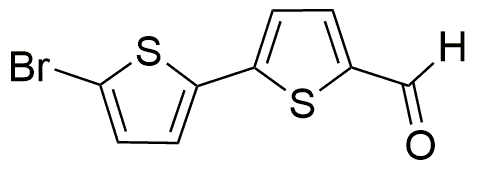5-Bromo-2,2'-bithiophene-5'-carboxaldehyde is widely utilized in research focused on:
- Organic Electronics: This compound serves as a key building block in the synthesis of organic semiconductors, which are essential for developing flexible and lightweight electronic devices such as organic light-emitting diodes (OLEDs) and organic photovoltaic cells.
- Material Science: Its unique properties make it suitable for creating advanced materials with tailored electronic and optical characteristics, which are crucial in the development of sensors and other electronic components.
- Pharmaceutical Research: The compound can be used in the synthesis of novel pharmaceutical agents, particularly in the field of drug discovery, where its structural features may lead to the development of new therapeutic compounds.
- Polymer Chemistry: It is employed in the production of conductive polymers, which have applications in various fields, including coatings, batteries, and supercapacitors, enhancing energy storage solutions.
- Photovoltaic Applications: The compound's ability to absorb light efficiently makes it a candidate for use in dye-sensitized solar cells, contributing to renewable energy technologies.
Información general
Propiedades
Seguridad y normativas
Aplicaciones
5-Bromo-2,2'-bithiophene-5'-carboxaldehyde is widely utilized in research focused on:
- Organic Electronics: This compound serves as a key building block in the synthesis of organic semiconductors, which are essential for developing flexible and lightweight electronic devices such as organic light-emitting diodes (OLEDs) and organic photovoltaic cells.
- Material Science: Its unique properties make it suitable for creating advanced materials with tailored electronic and optical characteristics, which are crucial in the development of sensors and other electronic components.
- Pharmaceutical Research: The compound can be used in the synthesis of novel pharmaceutical agents, particularly in the field of drug discovery, where its structural features may lead to the development of new therapeutic compounds.
- Polymer Chemistry: It is employed in the production of conductive polymers, which have applications in various fields, including coatings, batteries, and supercapacitors, enhancing energy storage solutions.
- Photovoltaic Applications: The compound's ability to absorb light efficiently makes it a candidate for use in dye-sensitized solar cells, contributing to renewable energy technologies.
Documentos
Hojas de datos de seguridad (HDS)
La SDS proporciona información de seguridad completa sobre la manipulación, el almacenamiento y la eliminación del producto.
Especificación del producto (PS)
La PS proporciona un desglose completo de las propiedades del producto, incluida la composición química, el estado físico, la pureza y los requisitos de almacenamiento. También detalla los rangos de calidad aceptables y las aplicaciones previstas del producto.
Certificados de análisis (COA)
Busque certificados de análisis (COA) ingresando el número de lote del producto. Los números de lote y de partida se pueden encontrar en la etiqueta de un producto después de las palabras "Lote" o "Lote".
Número de catálogo
Número de lote/lote
Certificados de origen (COO)
Este certificado de origen confirma el país en el que se fabricó el producto y también detalla los materiales y componentes utilizados en él y si se deriva de fuentes naturales, sintéticas u otras fuentes específicas. Este certificado puede ser necesario para cumplir con las normativas aduaneras, comerciales y regulatorias.
Número de catálogo
Número de lote/lote
Hojas de datos de seguridad (HDS)
La SDS proporciona información de seguridad completa sobre la manipulación, el almacenamiento y la eliminación del producto.
DownloadEspecificación del producto (PS)
La PS proporciona un desglose completo de las propiedades del producto, incluida la composición química, el estado físico, la pureza y los requisitos de almacenamiento. También detalla los rangos de calidad aceptables y las aplicaciones previstas del producto.
DownloadCertificados de análisis (COA)
Busque certificados de análisis (COA) ingresando el número de lote del producto. Los números de lote y de partida se pueden encontrar en la etiqueta de un producto después de las palabras "Lote" o "Lote".
Número de catálogo
Número de lote/lote
Certificados de origen (COO)
Este certificado de origen confirma el país en el que se fabricó el producto y también detalla los materiales y componentes utilizados en él y si se deriva de fuentes naturales, sintéticas u otras fuentes específicas. Este certificado puede ser necesario para cumplir con las normativas aduaneras, comerciales y regulatorias.

